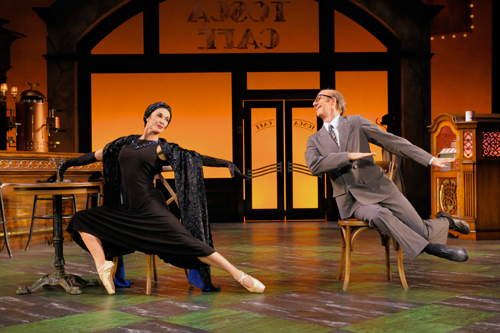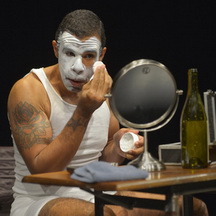
Theater v. history
It would be a mistake to call A.C.T.’s “The Tosca Project,” which opened on the Mainstage on June 3, a history of the Tosca Café, the famous café/bar that continues to live in the heart of North Beach, across the street from City Lights Bookstore and just down from the intersection of Broadway and Columbus.
A history is comprised of specific characters and events during a specific period of time. And although the play, which is really more of a dance or performance event, maps out cultural lifestyles intrinsic to 20th-century San Francisco, none of its characters are defined individuals, rather they are mélanges, mixtures of known personalities and types. Likewise, their interactions partake of the flavor of the past while veering from the journalistic.
So we see a man dressed like a cross between Mayakovsky and William Burroughs leaning against the café bar, reciting lines from Lawrence Ferlinghetti’s “I Am Waiting.” While both the poem and the poet are historical realities, their intersection in that particular way is unlikely.
Other historical personages take the stage as dreamlike figures, suggesting a world of memory or desire. After the wonderfully danced opening, during which the three “bartender/waiters” sashay around the café interior juggling trays of coffee cups, a young woman enters and the café darkens into gloom, a single spot on her and the table where she sits. A figure enters dressed as Nijinsky’s faun, his pose and steps recreating the beautiful old photos of the great modernist choreographer and dancer. From another corner of the room Pavlova’s dying swan bourreés into center stage. Where else can these creatures come from but the hungry, unrelenting impulses of memory?
Other figures appear with less of a historic connection. Who is the mysterious woman in the red dress, who is always at the back of the solitary café owner like a shadow of Time’s wingèd chariot?
Little is spoken, all is danced, as a host of characters ebb and flow through the café: little flappers Charleston; hipsters and socialites hang on the words of poets; hippies bestow kisses and shake their booties; a hare krishna chimes his circular way through ecstasy; disco dudes slither around the floor and each other, sandwiching a gorgeous ballet dancer dressed in black. Proving that if you have exquisite dancers doing what they do, not much else is needed. Just watching Pascal Molat of San Francisco Ballet dance one short, profoundly beautiful solo is enough.
Or is it?
Words v. actions
There are times when the lack of language—except for the Ferlingetti excerpt and another from Joseph Brodsky’s “Café Trieste: San Francisco”—seems oddly constrained, as if no one had known quite what to say in the fabrication of “The Tosca Project,” and there might be some truth to that. Neither dancers nor actors practice their art through the formulation of words or story. Nor, in fact, do directors or choreographers. Those actions are left to playwrights and librettists. Dancers, actors, directors are motivated and driven by interpretation.
Similarly, the device of a man haunted by memories of a lost love, who is never delineated, makes for a rather thin structure on which to hang the action of the performance.
So, what then is “The Tosca Project” about? And why is it engaging? Rather than the complications of witty dialogue and surprising plot, “The Tosca Project” is about ambience and emotional resonances. How well the actors and dancers pack their characters with feeling—pure and perfectly clear feeling—is the lynchpin of the action. To achieve this emotional clarity requires hundreds of back stories to be formulated and embellished. Whether or not they are logical or even consistent is somewhat irrelevant; what is more necessary is that they are absorbed and become complications in the performer’s mode of expression. And that’s what we have in these characters—not fact or history but the emotional potential of humans.
The span of human emotions, especially around love, is expansive in “The Tosca Project”—from the nostalgic despair of the bartender over his lady in red to the desperation of the musician over his fatally lost girl to the clownish antics of the business man as he emulates his ballet beauty in a pas de deux pose with a chair.
Storyline or not, the engagement between character and player and player and audience in “The Tosca Project” seems endlessly intriguing.
—Jaime Robles
“The Tosca Project” continues on A.C.T.’s Mainstage until June 27. For information and tickets, call (415) 749-2ACT or visit www.act-sf.org
Phot: A ballet diva (Sabina Allemann) enchants a businessman (Peter Anderson) in Tosca Cafe. By Kevin Berne.
